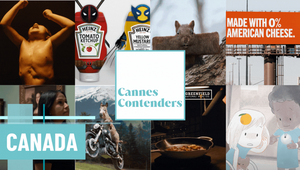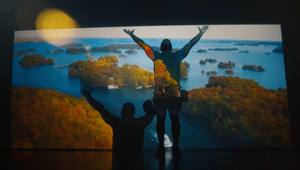
Embodying a Country: Dave Watson on Canada's Olympic Branding

The summer months are always jam-packed, but 2024 is going to be an especially crazy year for those in adland. Right now of course, there’s the invaluable discussions that come with Pride Month, mingling with the discourse of the Cannes Lions. Moreover, fans of the world’s most popular sport are also buzzing for the inevitable start of the UEFA Euro 2024 tournament, which, upon its conclusion, will almost immediately segue into one of the planet’s biggest, most notable sporting events: the Summer Olympic Games. So, truly, a piece of news has to be pretty big in order to make a splash against such a busy backdrop.
Nevertheless, one such example – and a consistent one at that – is the Team Canada Olympic uniforms, which, no matter the year or time, manage to make a national splash that reverberates into the industry. And, this is just how it should be. These jerseys, and the athletes in them, represent Canada as a country, and as a brand. Even if the initial release only sparks canuck attention, once that flame is lit, there will be eyes on it, and perceptions will be formed. Sure, onlookers might be expecting red, white and maple leaves, but even small things like the way they’re laid out, the colours and shades used, and, inevitably, the pattern choices matter a great deal. Will we look silly? Or will we show up, representing ourselves as the top tier competitors that we can be?
To this end, Dave Watson, head of design at Broken Heart Love Affair, is deeply passionate about just how important this whole affair is, and the subject of Canadian branding on the international stage. So, to explore some insights and opinions on Lululemon’s 2024 uniform, favourite all-time editions, and how he would personally want to approach the design process, Dave sat down with LBB’s Jordan Won Neufeldt for a chat.
LBB> From the top, what is the significance of Canada’s Olympic branding to you? How long have you been interested in it, and why does it matter?
Dave> I've always been captivated by the branding of Canada through the lens of sport, even before I knew I wanted to be a graphic designer. As a child, I was particularly struck by the uniforms of the 1987 Canada Cup hockey team. Their graphic and iconic design resonated with me, and I knew they were fitting for legendary players like Gretzky and Lemieux. Although the Canada Cup isn't part of the Olympics, it sparked a lifelong passion for the branding of Team Canada, which remains strong to this day.
The reason it matters is the same reason people fall in love with brands – they want to be associated with a company, group, or team that reflects their style or beliefs.
LBB> With that in mind, what do you perceive Canada’s brand as being? And how has this evolved over the years?
Dave> Pentagram’s Michael Beirut once said that branding is like an empty glass that needs meaning poured into it. The branding of Canada, and more specifically Team Canada, follows the same principle. I remember feeling a sense of shame for our country during the Ben Johnson doping scandal, but I also recall the immense pride and the strong visual identity we showcased during the Vancouver Winter Olympics. It's fascinating to see how the same country (and relatively the same maple leaf icon) can project such different brand images over time.
From a visual perspective, I've always admired when countries dare to try something different. Sometimes it works, like Nigeria’s 2018 World Cup uniforms and merchandise, and sometimes it doesn’t, like HBC’s denim jackets for the Tokyo Olympics. However, the courage to push the envelope is essential. We need more of this boldness not only in the sporting world, but also in the business world.
LBB> Do you think Canada’s brand is perceived differently on national and international levels? What factors contribute to this, and do you feel that the team is taking an effective approach to both with this year’s games?
Dave> Through the lens of the Olympics, I think our brand varies from sport to sport. When the men’s or women’s hockey teams pull on their uniforms, it probably sends chills down the opposing players’ spines. In events where we aren’t as dominant, it doesn’t have the same effect.
On a global scale, I believe we are still known as the ‘nice and polite’ country. That works for me because sometimes it’s the dog that doesn’t bark that you need to be afraid of. Let’s embrace that ‘strong silent type’ persona and use it to our advantage.
Within Canada, I believe we have never been as focused on success as we are today. For me, it was the introduction of the Own the Podium organisation that marked a turning point. We started to realise that if Canada wanted to succeed globally in sport, it was going to take money, focus, and hard work to help our athletes achieve their goals.
It has been 20 years since the launch of OTP, and it will be very interesting to see how it pays off this summer in Paris.
LBB> Obviously, a big part of branding is uniform design. So, what do you think of the Canadian uniforms this year?
Dave> I’m impressed by the Canadian uniforms for this year's Paris Olympics. They strike a nice balance between form and function. Lululemon's approach, involving 19 Canadian Olympic and Paralympic athletes across 14 different sports in the design process, speaks volumes about its commitment to performance.
The challenge of incorporating the maple leaf, a symbol deeply ingrained in our identity, was tackled with creativity by the Lululemon team. While the maple leaf might seem like a cliché to some, it holds huge significance for many Canadians. Yet, Lululemon managed to infuse it with new life, pushing it into a fresh new territory. They had to – it’s Paris after all.
LBB> Would you say they’re an upgrade over past iterations? And, looking at the history of the uniform, do you have any personal favourites that stand out?
Dave> As I mentioned earlier, I felt that the 2018 line missed the mark for me. While I really appreciated HBC for attempting something daring, it felt like we were leaning too heavily on Canadian clichés, and the humour felt a bit too niche. The lumberjack plaid, spray-painted denim jackets, and trucker hats came across as a bit forced.
Ironically, the line that HBC and Canadian fashion designers Dsquared created for the 2016 Rio Olympics remains one of my favourites. Minimalist, graphic, and bold were the defining features of that line. I still wear a full zip hoodie from that collection and get a ton of compliments on it.
LBB> Building on the discussion of evolution, do you agree with the decision to continually embrace the theme of red, white and maple leaves? Or do you think it’s time for something new?
Dave> I think that’s always going to be the creative brief. The challenge is how to embrace those elements and try to create something inventive. I think adding different reds or perhaps accent colours could work, but in the end, Canada is known world-wide for the red maple leaf.
LBB> As such, if you were to design the uniform, what would you want to do? What factors would influence your decision-making process?
Dave> What an opportunity it would be! As ever I would want to push the boundaries of the Canadian brand elements to create something that would elicit a (positive) emotional response from both athletes and fans; to find a balance between what is hot in sports fashion now, without being too trendy. That would be the biggest hurdle to overcome.
LBB> Seeing all the publicity the Olympic games, and subsequently the uniforms get, do you feel Canada will be marketed well at this year’s event?
Dave> As Bono once said, “The world needs more Canada”. The Paris Olympics is a great stage for our country to show that we aren’t only a powerhouse in athletics, but in marketing/branding as well. The hard work has been done – let’s hope that our athletes can take that next step and show the world what Canadians already know.
LBB> Finally, as a designer, what advice would you give people who are tasked with developing ads revolving around the games, which will influence perception of the Canadian brand?
Dave> I don’t think my advice is for creatives – the good ones are always pushing for better. Instead, my advice is for the CMOs and brand managers in Canada. Safe is boring. Safe is forgettable. Safe is a waste of your money. Trust your creative partners and empower them to create something emotive and meaningful. It WILL work.















